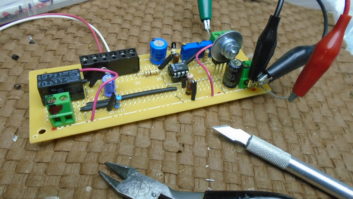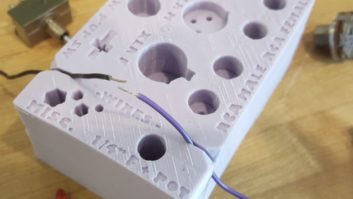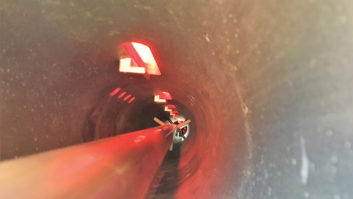Meter, Meter on the Wall Question from the June 13 issue
(Exam level: CBRE)
The analog DC ammeter with an actual full-scale value of 10 milliamperes in your transmitter that measures 1 ampere of plate current has failed and the only linear meter that fits in the same space available is a 1 mA unit. Could you use this available meter as a replacement?
a. Yes, with a series resistor of 10 k
b. Yes, with a series and parallel resistor both 10 k
c. No
d. No because the scale is set by the coil wind count
e. Yes, with a select parallel resistor across the meter contacts
SBE certification is the emblem of professionalism in broadcast engineering. To help you get in the exam frame of mind, this column poses typical questions. Although similar in style and content to the exam questions, these are not from past exams nor will they be on future exams in this exact form.

Fig. 1: Basic Meter Circuit With Series Resistor for Voltage Measurements Tentatively, let’s assume that the meter has no resistance, which will simplify our discussion for the moment. We’ll come back to this, I promise.
In the ultimate analysis, all analog DC meters are actually displaying current flowing through the meter coil that deflects the pointer. With that in mind, answer (a) would really be creating a meter that responds to voltage.
In Fig. 1, we have voltage impressed between the top of the series resistor and the negative terminal of our meter. The values shown of 10 volts and a series resistor of 10 k would cause a current flow of 1 mA or full scale on our replacement meter. When you buy a voltage meter, this series resistor is inside already.
To keep the parts acquisition count down, most transmitter manufacturers use the same model milliammeter in every position and a variety of this series resistor scheme to create the appropriate scale values for voltages. For example, a full scale of 3000 volts using a 1 mA meter would require a 3 megohm series resistor. Preferably, a precision resistor would be used in this instance to enhance accuracy.
The answer (b), with at least one of the 10 k resistors being in series, would make it impossible to use this meter as an ammeter to represent 1 ampere as that 10 k resistor would drop any impressed voltage notably. If you throw in the voltage divider action of that shunt 10 k resistor, the simple reality is that this arrangement is just a more complicated “voltage variable” version of Fig. 1.
The answer (c) is reserved for someone who either has no knowledge of the topic or didn’t get a good night’s sleep the night before the test! One should always come to SBE exams well rested and with a clear mind. This is the last choice to go with until all other options have been eliminated.
The wind count mentioned in answer (d) is a factor in creating the small DC resistance of the meter (that we decided above to discount momentarily), but is just one element involved in determining the full scale value.
HOW IT WORKS
To answer the question, (e) is correct, as we can increase the value displayed on this 1 mA meter to be calibrated to 1 amp FS with a parallel resistor, known as a shunt, across the meter contacts.

Fig. 2: Shunt Resistor for Current Measurement
How do we determine this shunt resistor, which will route all current above 1 ma around the meter leaving just an analogous, representative current to be displayed on the meter?
Meters do have resistance, and since we now need to consider parallel paths for current flow, we really need to know the actual value of the meter coil resistance. A typical value for a 1 mA meter is about 200 ohms. If you don’t know the meter resistance, you’ll have to ascertain what it is.
In most cases, it is easier to calculate (or measure) the voltage across the meter movement for full-scale display. If you don’t know the resistance, it can be measured with a digital multimeter. The current from most digital multimeters is low enough not to cause damage to the meter, but the pointer may swing rather violently. Connect with reverse polarity to minimize the risk of bending the pointer.
Fig. 2 shows our 1 mA meter with a shunt resistor across the meter contacts. We’ve assumed our meter’s internal resistance is 200 ohms. The voltage across the meter and the shunt is in parallel so Vs (= voltage across the shunt) is equal to Vm (= voltage across the meter winding). But we also know that Vs must be equal to the current through the shunt times the shunt resistance and that Vm must be equal to the current through the meter times the meter resistance.
In shorthand here are the relationships:
Vs = Vm; and
Is × Rs = Im × Rm
We can solve for Rs (shunt resistance) by rebalancing the equation:

Fig. 3: Variable Shunt Resistor
Rs = (Im × Rm) / Is
Substituting Iin – Im for Is yields:
Rs = (Im × Rm)/(Iin – Im)
Let’s give it a try using that typical 200 ohm value for the ammeter resistance value.
Rs = (0.001 amp × 200 ohms) / (1 amp – 0.001 amp)
Rs = 0.2 volt / 0.999 amps
Rs = 0.2002002 ohms
At this low a resistance value, the pragmatics of creating a pure and exact resistance at that small value are important, as even stray resistance of the connection wires can affect measuring accuracy. Special wire and bar stock are made just for the purpose of achieving small resistance values with high current handling. Most often a manganin and/or constantan alloy that exhibits a low coefficient of resistance change with temperature is used for highest accuracy across the current range of interest. Most full-line meter manufacturers usually have shunts available off the shelf to multiply their ammeters scales in standard values.
In the example above, if ultra accuracy is needed, a 2 ohm shunt would be used and a small value “trim” pot can be added in series with the meter (see Fig. 3). Small in our case would be a 25 to 50 ohm (usually multi-turn) pot. Referenced against laboratory grade instruments, the trim pot would be adjusted to match and double checked at full scale as well as several intermediate values of current.
The next SBE certification exams will be given in the local SBE chapters Nov. 2–16. Closing date for signing up is Sept. 14. If you are interested and ready to take the exams, we strongly suggest that you sign up ASAP, as the next exams are scheduled for Feb. 8–18, 2013.
Charles “Buc” Fitch, P.E., CPBE, AMD, is a frequent contributor to Radio World. Graphics were drawn by Victor Osorio, the full-time CE at HRRZ AM and HRKD FM in Juticalpa, Olancho, Honduras. Reach him at [email protected].
Missed some Certification Corners or want to review them for your next exam? Find past Certification Corner articles under the Columns tab at radioworld.com.
The Mismatch Patch (Exam level: CBNT)
A cabling impedance mismatch can be caused by which of the following?
a. Using RJ45 connectors on Cat-6 cable.
b. Running cable in an overhead cable tray near electrical conductors.
c. Nicking cable conductors when stripping.
d. Mixing shielded and unshielded twisted pair cable in the same segment.
e. Not following ITE/EIA/IEEE standard UTP-101 regards wire twist format (i.e. left overhand)












